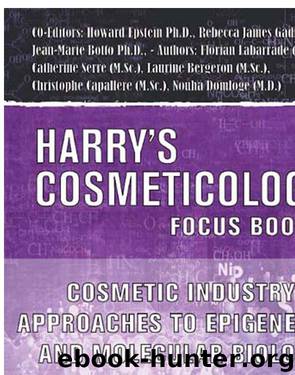Cosmetic Industry Approaches to Epigenetics and Molecular Biology by Rebecca James Gadberry Howard Epstein Jean-Marie Botto

Author:Rebecca James Gadberry,Howard Epstein,Jean-Marie Botto
Format: epub
Publisher: Chemical Publishing Company
Published: 2015-11-20T16:00:00+00:00
GLOSSARY:
3’UTR: 3’ untranslated region of a messenger RNA, located downstream of the stop codon.
AGO2: Argonaute 2 is encoded by AGO2 gene and is implicated in short interfering RNA mediated gene silencing.
BAT: Brown adipose tissue: Tissue specialized to burn lipids for heat generation and energy expenditure as a defense against cold and obesity.
B-MYB: V-Myb Avian Myeloblastosis Viral Oncogene Homolog-Like 2. B-myb is a member of the myb family of transcription factor, encoded by MYBL2 gene, and is a nuclear protein involved in cell cycle progression.
C/EBP β: CCAAT/enhancer binding protein beta, encoded by CEBPB gene. The protein can bind the promoter and upstream element and stimulate the expression of the collagen type I gene, and is also implicated in immune and inflammatory responses.
DICER1: A Ribonuclease III family enzyme. Dicer was given its name by Emily Bernstein, a graduate student at Cold Spring Harbor Laboratory, who first demonstrated the dsRNA “dicing” activity of this particular enzyme.
DGCR8: DiGeorge syndrome critical region 8. This gene encodes a subunit of the microprocessor complex that mediates the biogenesis of microRNAs.
DROSHA: A Ribonuclease III family enzyme implicated in microRNA processing. The “microprocessor” is a complex comprising the RNase III enzyme Drosha and the double-stranded RNA-binding protein DGCR8, catalyzing the nuclear step of microRNA biogenesis.
ECM: Extracellular matrix. ECM is the extracellular scaffold present in all kinds of tissues, involved in tissue morphogenesis, differentiation, and homeostasis.
ERK5: Extracellular signal-regulated kinase 5. ERK5 is a member of the MAP (mitogen-activated protein) kinase family. Synonym: Mitogen-Activated Protein Kinase 7 (MAPK7).
FSCN1: Fascin Homolog 1, Actin-Bundling Protein. This gene encodes a member of the fascin family of actin-binding proteins.
iASSP: Apoptosis stimulating proteins of p53 (ASSP) inhibitor. Also known as Protein Phosphatase 1, Regulatory Subunit 13 Like (PPP1R13B-Like).
miR: MicroRNA. A category of noncoding ribonucleic acids (RNAs).
MITF: Microphthalmia-associated transcription factor. The corresponding protein regulates the expression of melanogenesis enzyme genes.
mRNA: Messenger ribonucleic acid.
MYO5A: Myosin VA is an actin-based motor protein involved in cytoplasmic vesicle transport and mRNA translocation.
NHEM: Normal human epidermal melanocyte.
NHF: Normal human fibroblast.
NHK: Normal human keratinocyte.
Orthologous genes: Relates to genes for which the homology is the result of speciation. Orthologous genes are hence encountered in different species.
Paralogous genes: Relates to genes for which the homology is the result of gene duplication.
PKC: Protein-kinase C is a family of serine- and threonine-specific protein kinases involved in diverse cellular signaling pathways, that can be activated by calcium and diacylglycerol, and phosphorylate in a wide variety of protein targets.
PPARg: Peroxisome proliferator-activated receptor gamma nuclear receptors. PPARs form heterodimers with retinoid X receptors (RXRs), thus regulating the transcription of various genes.
pRb pathway: Retinoblastoma (Rb) pathway, involved in the control of cell proliferation and apoptosis.
RAB27A: Gene encoding a ras-related protein, belonging to the rab family of small GTPases.
RAN-GTP: RAS-related nuclear protein, binding a GTP molecule.
RISC: RNA-induced silencing complex, also known as RISC loading complex (RLC), or microRNA loading complex (miRLC). RISC is composed of DICER1, AGO2, and TRBP.
RNase III: Ribonuclease III enzyme. DROSHA and DICER1 are RNAse III enzymes.
RQ: relative quantification. RQ allows expressing of changes in gene expression, in a given condition, relative to a reference condition (e.
Download
This site does not store any files on its server. We only index and link to content provided by other sites. Please contact the content providers to delete copyright contents if any and email us, we'll remove relevant links or contents immediately.
| Cell Biology | Developmental Biology |
| Entomology | Marine Biology |
| Microbiology | Molecular Biology |
| Biostatistics |
Sapiens: A Brief History of Humankind by Yuval Noah Harari(14319)
The Tidewater Tales by John Barth(12625)
Mastermind: How to Think Like Sherlock Holmes by Maria Konnikova(7278)
Do No Harm Stories of Life, Death and Brain Surgery by Henry Marsh(6905)
The Thirst by Nesbo Jo(6877)
Why We Sleep: Unlocking the Power of Sleep and Dreams by Matthew Walker(6654)
Life 3.0: Being Human in the Age of Artificial Intelligence by Tegmark Max(5512)
Sapiens by Yuval Noah Harari(5322)
The Longevity Diet by Valter Longo(5040)
The Body: A Guide for Occupants by Bill Bryson(5027)
The Rules Do Not Apply by Ariel Levy(4910)
The Immortal Life of Henrietta Lacks by Rebecca Skloot(4548)
Animal Frequency by Melissa Alvarez(4424)
Why We Sleep by Matthew Walker(4394)
The Hacking of the American Mind by Robert H. Lustig(4338)
Yoga Anatomy by Kaminoff Leslie(4332)
All Creatures Great and Small by James Herriot(4269)
Double Down (Diary of a Wimpy Kid Book 11) by Jeff Kinney(4240)
Embedded Programming with Modern C++ Cookbook by Igor Viarheichyk(4141)
